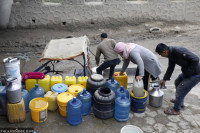Money
Breakthrough likely in Nepal-India energy talks slated for October
The major sticking point is the financing modality for the New Butwal Gorakhpur transmission line project..jpg&w=900&height=601)
Prahlad Rijal
The announcement comes a day after Nepali and Indian energy ministers expressed optimism that the secretary-level meeting would remove the hindrances in the way of the strategic 400 kV New Butwal Gorakhpur transmission line project, the major component of a $630 million pact between Nepal and US Millennium Challenge Corporation.
“Our Indian counterparts have agreed to hold deliberations over the financial and implementation modalities of the crucial power infrastructure in mid-October,” said Dinesh Ghimire, secretary of the Ministry of Energy, Water Resources and Irrigation. “We are now awaiting written confirmation of the proposed dates of October 14, 15 and 16 to hold the crucial meeting.”
According to Ghimire, officials will try to forge an agreement on making an equal equity investment in the transmission line as discussed by officials of the Nepal Electricity Authority and the Central Electricity Authority of India two months ago.
Earlier, officials from the two countries had reached a broad agreement that the portion of the transmission line passing through Indian territory would be built by a commercial entity after India rejected Nepal’s proposal to develop the line under a government to government financial model.
The meeting slated to be held in June in Bengaluru, India was delayed owing to the Indian general elections and subsequent bureaucratic reshuffles.
Last month, the fifth meeting of the Nepal-India Joint Commission chaired by the foreign ministers of the two countries had also called for early finalisation of the financing modalities by the Nepal-India Joint Steering Committee and Joint Working Group while appreciating the work of both power utilities and other technical teams in laying the groundwork for the crucial infrastructure.
As per a report issued by the National Renewable Energy Laboratory’s Strategic Energy Analysis Centre of the US in April, Butwal is a strategic location for cross-border energy trade between India and Nepal because of its proximity and ability to connect with India’s Uttar Pradesh state and the Northern Regional Load Dispatch Centre via Gorakhpur where power demand is high during the monsoon.
“The project is of strategic importance to both Nepal and India as it will allow the power utility to export surplus energy to India at reasonable rates and set up a reliable route for energy banking while synchronising our power grid with India’s,” said Prabal Adhikari, spokesperson for the Nepal Electricity Authority.
“The Indian power minister has assured us that he will forward his directions to energy officials in India to find common ground to implement the New Butwal Gorakhpur transmission line at the upcoming meeting.”
Despite multiple meetings in the past, an agreement on the financing of the transmission lines has remained elusive as officials have time and again raised questions over the commercial viability of the arrangement. But the talks are expected to take a positive turn at the upcoming meeting with an agreement also in sight.
According to the Nepal Electricity Authority, the detailed project report of the cross-border transmission lines has been updated and revised by India in consultation with power utility officials which has led to a cost reduction of around $18 million on the Indian portion of the transmission line.
“Bilateral understandings on the development modality related to funding and implementing agency are on the verge of being finalised,” said the Nepal Electricity Authority.
An agreement between officials of the two neighbouring countries on implementing the 135-km New Butwal-Gorakhpur transmission line is also a prerequisite for the multi-million dollar MCC-Nepal compact—viewed by many in Nepal as a counter-initiative under the Indo-Pacific strategy of the US administration against China's Belt and Road Initiative—to become effective.
The compact was expected to enter into force by September 2019. But in view of the impediments, the Millennium Challenge Account-Nepal, which is the implementing agency of the strategic road and transmission projects announced last month that the agreement would only go into effect from June 2020.
Of the conditions precedent over the implementation of the project, the government has already declared the transmission project as a national priority project and legislation has been passed forming the Electricity Regulatory Commission this year. The conditions are only two of the six prerequisites of entry into force.
The Compact, which will prevail over domestic laws, has been tabled in Parliament but it is yet to be ratified.
Apart from the New Butwal-Gorakhpur transmission line, the working group and steering committee meeting is also expected to assess the prospects of building two new 400 kV power lines, Lumki-Bareilly and New Duhabi-Purnea, by 2025 in line with surplus energy projections made by the Nepal Electricity Authority.
As per the power utility's estimate, Nepal will have a surplus of around 8,000 megawatts by 2025 as the country's generation capacity is expected to reach 10,924 megawatts while peak demand is likely to amount to 2,981 megawatts.
Accordingly, Nepali officials are also expected to urge their Indian counterparts to establish government policies related to energy banking in India which will allow its power sector regulator to formalise energy exchange between Nepal and India which is currently done through mutual agreement.
In the fiscal year 2018-19, Nepal imported 2,813.07 gigawatt hours of energy worth over Rs22 billion through various transmission links including Dhalkebar-Muzaffarpur, and exported 34.74 gigawatt hours worth Rs318.12 million to the Indian state of Bihar through an exchange mechanism under the purview of the Nepal-India power exchange committee.
The secretary-level meeting slated for October will also carry out deliberations on increasing the capacity of the Dhalkebar-Muzaffarpur transmission line in view of the export-oriented Arun 3 hydel being developed by India’s state contractor to evacuate 900 megawatts to India.




 7.12°C Kathmandu
7.12°C Kathmandu















